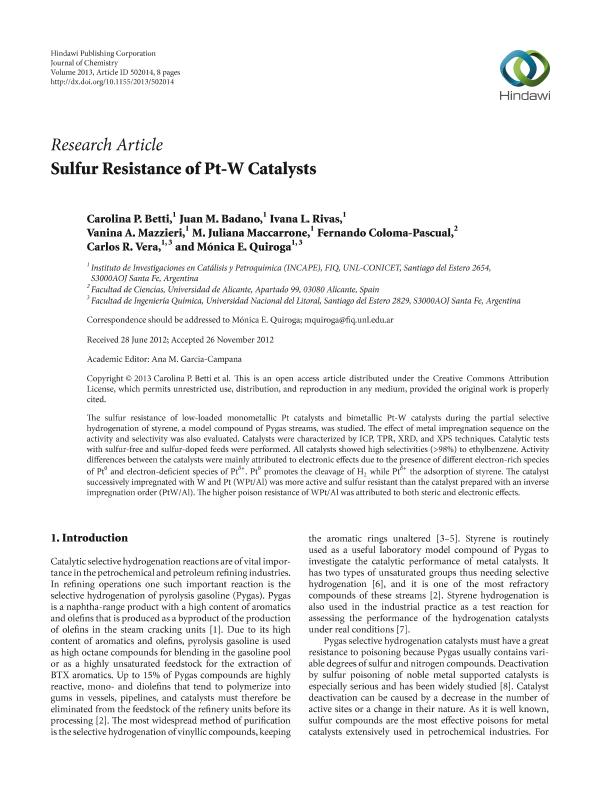Artículo
Sulfur Resistance of Pt-W catalyst
Betti, Carolina Paola ; Badano, Juan Manuel
; Badano, Juan Manuel ; Rivas, Ivana Lorena; Mazzieri, Vanina Alejandra
; Rivas, Ivana Lorena; Mazzieri, Vanina Alejandra ; Maccarrone, María Juliana
; Maccarrone, María Juliana ; Coloma Pascual, Fernando; Vera, Carlos Roman
; Coloma Pascual, Fernando; Vera, Carlos Roman ; Quiroga, Monica Esther
; Quiroga, Monica Esther
 ; Badano, Juan Manuel
; Badano, Juan Manuel ; Rivas, Ivana Lorena; Mazzieri, Vanina Alejandra
; Rivas, Ivana Lorena; Mazzieri, Vanina Alejandra ; Maccarrone, María Juliana
; Maccarrone, María Juliana ; Coloma Pascual, Fernando; Vera, Carlos Roman
; Coloma Pascual, Fernando; Vera, Carlos Roman ; Quiroga, Monica Esther
; Quiroga, Monica Esther
Fecha de publicación:
01/2013
Editorial:
Hindawi Publishing Corporation
Revista:
Journal of Chemistry
ISSN:
2090-9063
Idioma:
Inglés
Tipo de recurso:
Artículo publicado
Clasificación temática:
Resumen
The sulfur resistance of low-loaded monometallic Pt catalysts and bimetallic Pt-W catalysts during the partial selective hydrogenation of styrene, a model compound of PYGAS streams, was studied. The effect of metal impregnation sequence on the activity and selectivity was also evaluated. Catalysts were characterized by ICP, TPR, XRD and XPS techniques. Catalytic tests with sulfur-free and sulfur-doped feeds were performed.All catalysts showed high selectivities (> 98%) to ethylbenzene. Activity differences between the catalysts were mainly attributed to electronic effects due to the presence of different electron-rich species of Pt0, and electron-deficient species of Ptä+. Pt0 promotes the cleavage of H2 while Ptä+ the adsorption of styrene. The catalyst successively impregnated with W and Pt (WPt/Al) was more active and sulfur resistant than the catalyst prepared with an inverse impregnation order (PtW/Al). The higher poison resistance of WPt/Al was attributed to the presence of chloride that inhibits the adsorption of thiophene because of steric and electronic effects. On the other hand, the lower concentration of chloride and a high concentration of Pt0 electron-rich sites (with low BE values) could contribute to the poisoning, as these species would act as electron donor sites, providing available electrons to be bond with the S atom of thiophene. Both effects would promote a strong adsorption of thiophene and thus an enhanced blocking of the catalyst active sites.
Archivos asociados
Licencia
Identificadores
Colecciones
Articulos(INCAPE)
Articulos de INST.DE INVEST.EN CATALISIS Y PETROQUIMICA "ING. JOSE MIGUEL PARERA"
Articulos de INST.DE INVEST.EN CATALISIS Y PETROQUIMICA "ING. JOSE MIGUEL PARERA"
Citación
Betti, Carolina Paola; Badano, Juan Manuel; Rivas, Ivana Lorena; Mazzieri, Vanina Alejandra; Maccarrone, María Juliana; et al.; Sulfur Resistance of Pt-W catalyst; Hindawi Publishing Corporation; Journal of Chemistry; 2013; 1-2013; 1-8
Compartir
Altmétricas



